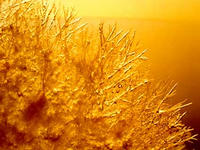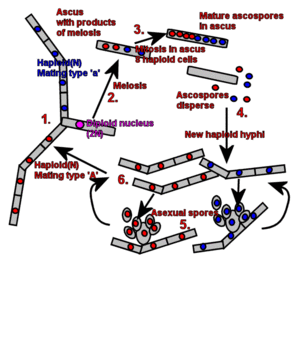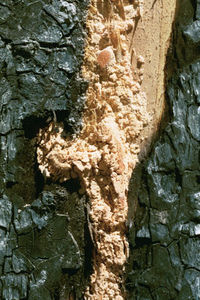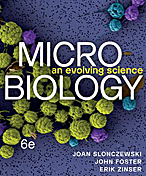Neurospora
A Microbial Biorealm page on the genus Neurospora

Classification
Higher order taxa
Eukaryota; Fungi/Metazoa group; Fungi; Ascomycota; Pezizomycotina; Sordariomycetes; Sordariomycetidae; Sordariales; Sordariaceae
Species
Neurospora crassa
Neurospora intermedia
Neurospora tetrasperma
|
NCBI: Taxonomy Genome |
Description and Significance
The classification Neurospora contains both yeasts and fungi. Neurospora is commonly known as orange bread mold. It first recieved major attention in 1843, when there was a Neurospora infestation in French bakeries. Neurospora was domesticated for research purposes in the 1920s.
Genome Structure
Borkivich and Krystofova (2003) have catalogued Neurospora genes. Neorspora contains approximately 10,000 genes, which is less than had been predicted. In most filamentous fungi, growth, morphogenesis, and virulence are controlled by a cyclic AMP (cAMP)-dependent protein kinase pathway. Neurospora crassa contains a gene called poi-2. It is expressed in starved and sexual tissues. The job of this gene is to encode a 27-kDa protein. Kim and Nelson (2005) created poi-2 mutants which showed two patterns. The first was typical Repeat-induced point mutation (RIP); the second was insertion-deletion (indel) mutation. Both mutations showed reduced growth and fertility. They concluded that the poi-2 gene is responsible for differentiating female reproductive strucutres, perithecial development, and normal growth. They also noted that the POI2 protien is probably a common pathway in the mating response. Neurospora crassa also has an unusual defense mechanism: RIP. This helps the organism destroy foreign DNA. RIP is a process that occurs during a sexual cross. A great deal of genetic research on Neurospora has been done at the molecular level. For example, Cahan and Kennell (2005) have done research illustrating similarities between four plasmids in wild-type mtDNA of Neurospora crassa and other fungal mitochondrial genomes. Some researchers have used the genetic structure of Neurospora to better understand biological processes. Fleissner et. al. (2005) used a mutant, called a so mutant, from the species Neurospora crassa to better understand cell fusion and cell-to-cell communication. This mutant has a pleiotropic phenotype, and has defects in in germling and hyphal fusion. The results of the study indicate that so is required for cell fusion.
Cell Structure and Metabolism

Neurospora crassa as a model organism for geneticists by Paul Decelles
Neurospora cell structures share many common characterisics with other eukaryotes. The cytoplasm is enclosed in a plasma membrane, and cell walls are typically compose of chitin. There are at least twelve specialized cell types. The three most common are hyphal, condidium, and ascospore cells. The walls of hyphal cells are rigid, except at the tips, where growth occurs. Conidial anastomosis tubes (CATs) are specialized hyphae. They are produced by cr-1 mutant lacking cyclic AMP (cAMP) in conidia and conidial germ tubes in Neurospora crassa. CATs are distinct from the germ tube. Physiologically, they are smaller, have determinate growth, and grow toward each other. Ascospores act as units of dispersal. They are more resistant to stress than conidia.
The way Neurospora grows depends on what type of organism it is. Yeasts grow through cell division, while filamental fungi grow by tip extension and branching. Neurospora fungi are one of the fastest-growing filamental fungi, with a rate of about ten centimeters per day.
It has been shown that Neurospora have a circadian rhythm, called the sporulation rhythm. If at some point mycel is transferred from a high-light and high-nutrient environment, to a low-light, low-nutrient one, the circadian oscillator will begin. These circadian rhythms are caused by compensation mechanisms within cells. They are the physiological clocks of organisms.
Neurospora often utlizes burnt plant matter as a food source. In addition, they are known to grow on bread and other food products. These organisms are heterotrophic.
Because they are members of Ascomycota, Neurospora reproduce sexually and asexually. Neurspora organisms spend most of their lives as haploid organisms.There are three different sexual life cycles: heterothallic, homothallic, and pseudohomothallic. In a heterothallic life cycle, Neurospora have two mating strains, A and a. Strains are determined by alternate DNA sequences at a chromosomal locus. Mating can only occur between different strains, which results in diploid cells in long sacs. Meiosis produces four haploid cells. These haploid cells undergo mitosis within the ascus, forming eight spores. N. crassa is a heterothallic species. In homothallic reproduction, an individual haploid strain can undergo sexual reproduction without pairing with another strain.To undergo meiosis, a diploid nucleus forms by the fusion of two haploid nuclei. N. galapagoensis is a homothallic species. In pseudohomothallic reproduction, a spore will grow into a dual mating type mixture of nuclei. It can then go through the sexual cycle without having to pair with anything. N. tetrasperma is a pseduohomothallic species. In the asexual cycle, spores germinate and form mycel, which produce aerial hyphae, which produce comidia.
Ecology

At first, it was believed that Neurospora only inhabited tropical and subtropical areas. However, it has also been found living in temperate forests. Species diversity differs based on geographical location. For example, the majority of North America is home to Neurospora discreta, the least common species of Neurospora. Southern Europe, however, is home to four species: N. crassa, N. discreta, N. sitophila, and N. tetrasperma.
Neurospora is known for its ability to germinate after forest fires; it helps to decompose burnt organisms.
Neurospora is highly valued for research purposes. First, it is easy to grow. Second, its simple life cycle makes it easy to study genetics and map genes. Because its characteristics make it ideal for scientific research, Neurospora is considered a model organism.
References
Decelles, Paul. Neurospora crassa as a model organism for geneticists.
Ruoff, Peter. The Sporulation Rhythm of Neurospora crassa: Example of a Circadian Clock Rhythm.
"UC Riverside scientists contribute to study that unveils genome sequence of bread mold."
